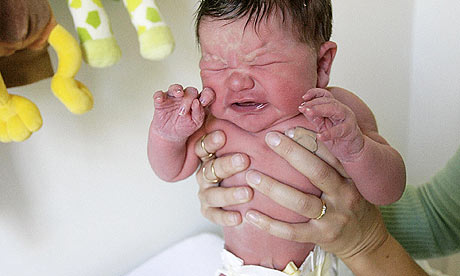
When it comes to giving birth, more mothers-to-be are deciding that there's no place like home. In what can be a painful and at times scary experience, it is easy to imagine the appeal of creature comforts, far away from the clinical environment of a hospital.
"The nicest thing was after the birth I could have a bath in my own home, sit on the sofa, and watch TV with a cup of tea," says Katrina Fox, 29, a full-time mother from Bournemouth who gave birth to her daughter Casia at home eight months ago. She joins a growing number of women who have decided to have a home birth. Though still only accounting for less than 3% of births in the UK, the Office of National Statistics shows there has been an 8% increase in the number of home births since 2006, and this figure is thought to be rising.
Any expectant mother reading recent NHS headlines may quite understandably be apprehensive. The NHS Information Centre has revealed that nearly one in four babies in England are still being delivered by caesarean section, despite additional risks to both mother and baby. The Royal College of Midwives has accused the government of putting babies' lives in danger due to the shortage of midwives. This comes at a time when maternity wards are struggling to cope with the highest birth rate seen since 1991.
There has long been debate regarding the safety of home births, with concerns that midwives cannot provide the support and expertise needed to solve serious complications during labour. However, a recent Dutch study published in the British Journal of Obstetrics and Gynaecology concluded home births were just as safe as hospital births, having found no difference in the mortality rates of 530,000 births by low-risk mothers. Such findings certainly invite a re-evaluation of home births in the UK and the infrastructure in place to support them.
Though in theory almost any woman can choose to have a home birth, only low-risk mothers are advised to have them. Statistically less likely to suffer complications in labour, these are women in good health who have not had caesareans or unexplained stillborns in the past. Allie Hughes, a 29-year-old postgraduate from Suffolk, made the decision to have a home birth despite being classed as a high-risk. "I was considered a high-risk due to being a bit overweight, and so I wasn't supposed to have a home birth. I went against hospital policy as I hated the hospital experience the first time I gave birth."
Hughes gave birth to her second daughter Elizabeth at home four weeks ago, and is a strong advocate for home births. "It's just so much more relaxed and a much better experience. The fact that you're at home in your own space with two midwives the whole time means you're not stressing as you have the full attention of them," she says.
Fox agrees that home birthing is a much calmer experience, and one that requires little preparation. "For a hospital birth, you have to make sure everything you need is in a bag ready for you to go. Women obviously used to have their babies at home many years ago and they didn't make a big fuss over it. Really all you need is a clean area, towels to wrap the baby in, and something to cover your floors."
"Definitely buy some plastic sheeting, black bin liners if it comes to a push", advises Mervi Jokinen of the Royal College of Midwives. Glamorous it may not be, but the simple requirements for a home birth may come as a welcome surprise to those conditioned by the drama of frantic hospital scenes. "It's amazing but it really needs quite minimal preparation", says Jokinen. "In reality, it's just making it comfortable for you. It's about how you feel in your own home."
There are very few restrictions on the type of home where a birth can take place, aside from sanitation issues and the risk of any physical threats. "Restrictions have softened now as we understand that most of the residences are suitable for home births. If it is a 12-storey tower block and the lift doesn't work then it might not be suitable, but you have to be assessing it on an individual basis," says Jokinen.
It can be difficult to forget about the neighbours, though. "I decided in the end to have the birth in the conservatory and it was kind of overlooked by the neighbours," says Fox. She solved the problem with some makeshift curtains. Hughes, on the other hand, had her first daughter, Charlotte, in a first-floor flat. "I just warned my neighbours beforehand as they were directly below and above me. They were old dears and were very excited and thought it was lovely."
As relaxing and intimate an experience as home births can be, the hospital cannot be removed from the equation altogether. About a quarter of home birthers will end up being transferred to hospital during or after labour, which is an area of concern for critics. There are a number of complications that can require transferral to hospital, including shoulder dystocia, haemorrhaging and breech births. A 2008 study by the National Collaborating Centre for Women's and Children's Health found that a transferral increases the risk of the baby dying by eight times the national average. Despite this, there are no set restrictions on the distance between the birthplace and the hospital.
The government has pledged that every woman will have the option of a home birth by the end of the year. The lack of resources and midwives currently in place suggests this target may not be met. Even so, it seems that more women will continue to forgo the maternity ward for the front room, hedging their bets on a better experience at home.

